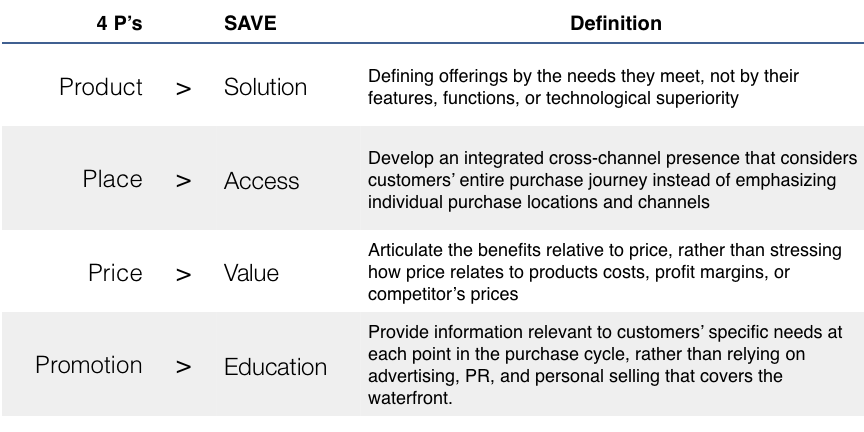B2B customers have changed their buying behaviors and, like it or not, you have to adapt. You have to SAVE your product business.
“Rethinking the 4 P’s” published in the Jan-Feb 2013 issue of the Harvard Business Review introduces a new model for B2B sales & marketing the authors call “SAVE” (Solution-Access-Value-Education). It is a reinterpretation of the classical “4 P’s of marketing” as they apply to today’s business-to-business environment.
The authors developed this model based on a five-year study with more than 500 managers and customers across a wide range of B2B industries. While that gives the model credibility when published in HBR, that’s not why I’m writing about it. For me, SAVE captures the way sales and marketing has changed and serves as a guide to implementation for product businesses.
Product vs Solution
The classical product approach is to describe your offering in terms of its attributes: dimensions, performance specs and the like. Some of this is necessary so customers can make sure your offering fits properly. But if that’s all you have to say then you’re no better than the next supplier. Selling in this environment defaults to price & delivery, feeds & speeds. In a word, you have become a commodity. An indistinguishable interchangeable part.
Whether you manufacture widgets or develop enterprise software applications, the output of your efforts plugs into your customer’s business model. If you are selling cogs they need to fit the wheel–but what if you provided the whole wheel? Would you save your customer time and money? Step back and ask yourself: why do customers need your offering? What pain points are you addressing?
Look at the challenge from your customer’s point of view. How do they use this product? Review their buying process and how your product fits with other elements of their business, upstream and downstream. In other words, put yourself in their shoes. How do you help them–and more importantly, how could you help them even more? The answers start you on the path away from commodity and toward a customer focused solution.
Place vs Access
I remember buying a car in the early days of the internet. All the major brands had a website with their models listed. After browsing and finding something interesting they forced you to send an email to the local dealer. This is the car salesman you were looking to avoid in the first place! Did they ever get back to you? In those early days, no, probably not.
Car companies have much more innovative websites and apps these days, but you still have to buy the car from a dealer–or do you? Tesla is the only manufacturer I know of that lets you buy directly online, but people buy used cars on eBay and Craigslist every day. The major brands are locked in to local dealers by law (they’re suing Tesla), but how about you and your customers? Are you locked in to the old ways of selling and supporting your products?
How do distributors, manufacturer reps, value-added resellers and other sales channels fit with your online strategy? These partners can be a huge asset. They have existing relationships with customers and can cross-sell your products. Maybe they add the services component that helps your customer get things up and running. Be sure you understand how they fit in to the big picture. If you simply pass leads along to an unresponsive channel, aren’t you repeating what the auto companies did 10 years ago?
Take a look at your competitors. You may find them selling through Amazon Industrial & Scientific or eBay. If your offering can be bought and sold through these channels, do you really want to forward that lead to your distributor? You need to make sure that your offerings are accessible through the channels your customers are using.
Price vs Value
How did you determine your prices–and when? If you are like most companies, you used a cost-based model to achieve your target margins. And you did it when the products came out and have only increased them based on your own costs rising. There is a lot of inertia around pricing. It’s difficult to change in the face of your own historical prices, never mind the competitive environment.
About a month ago, the pharmaceutical company Gilead Sciences won FDA approval for a new hepatitis C drug that can cure (not just treat) 50-90% of patients with the virus. The treatment involves a once-a-day pill for 28 days–avoiding chronic ongoing costs for patients, insurance companies and the healthcare system in general. The wholesale price has been announced at $1,000 per pill.
Now I’m not trying to start a debate on healthcare, only making a point about setting value. This example shows how Gilead is looking at the total picture–which is what you need to do. How does your solution address the broader needs of your customer? If your products are the equivalent of aspirin it’s time to rethink your offering. How can you address broader challenges facing your customers?
Promotion vs Education
Today’s customers–executives, engineers, procurement managers–are just like you. When they need an answer they don’t pull out the encyclopedia or a catalog; they search online. When they search, will they find you or your company’s offerings? Do you have information designed to answer their questions?
Way back in the dark ages I was an engineer riding the digital wave into the automation industry. My company had a logical progression of customer materials. Of course there was the enormous catalog and data sheets, but we also had targeted application and technical publications. Our engineers were encouraged ($ bonus) to write technical articles and get them published. We had a series of “application notes” covering how to measure or control various processes. Some of our better known engineers would be asked to speak at industry conferences and customer meetings.
Over the years many of those efforts fell by the wayside in favor of promoting the latest microprocessor or field bus technology. The idea of engineers having time to write papers on company time seems quaint now. But guess what–it’s time for a comeback.
In today’s terminology “content marketing” and “inbound marketing” are strategy elements to engage prospects and customers with meaningful information. For complex sales processes this means having information that addresses questions at each stage of the buying process. For shorter sales cycles it means having more application oriented information that raises the prospect’s confidence and positions your organization as an expert in the field.
Applying the SAVE model to your product business
Yogi Berra said “In theory there is no difference between theory and practice. In practice there is”. Each of these four transformations seems simple on the surface. The hard work comes from defining and implementing the changes.
While the initial “4 P’s” refer to marketing, the SAVE model involves the whole company. That means you can’t market a solution if you’re still behaving like a product company. Value-based pricing isn’t about raising prices, it’s about raising the value you deliver and getting compensated appropriately.
Implementing SAVE is worth the effort. The benefits include increasing gross margins, creating efficiencies in your sales & marketing efforts and dropping more profit to the bottom line. And it doesn’t take super-human abilities to get it done.
Jay Galasso, Managing Director
B2B Growth Partners
Twitter: @JayGalasso

